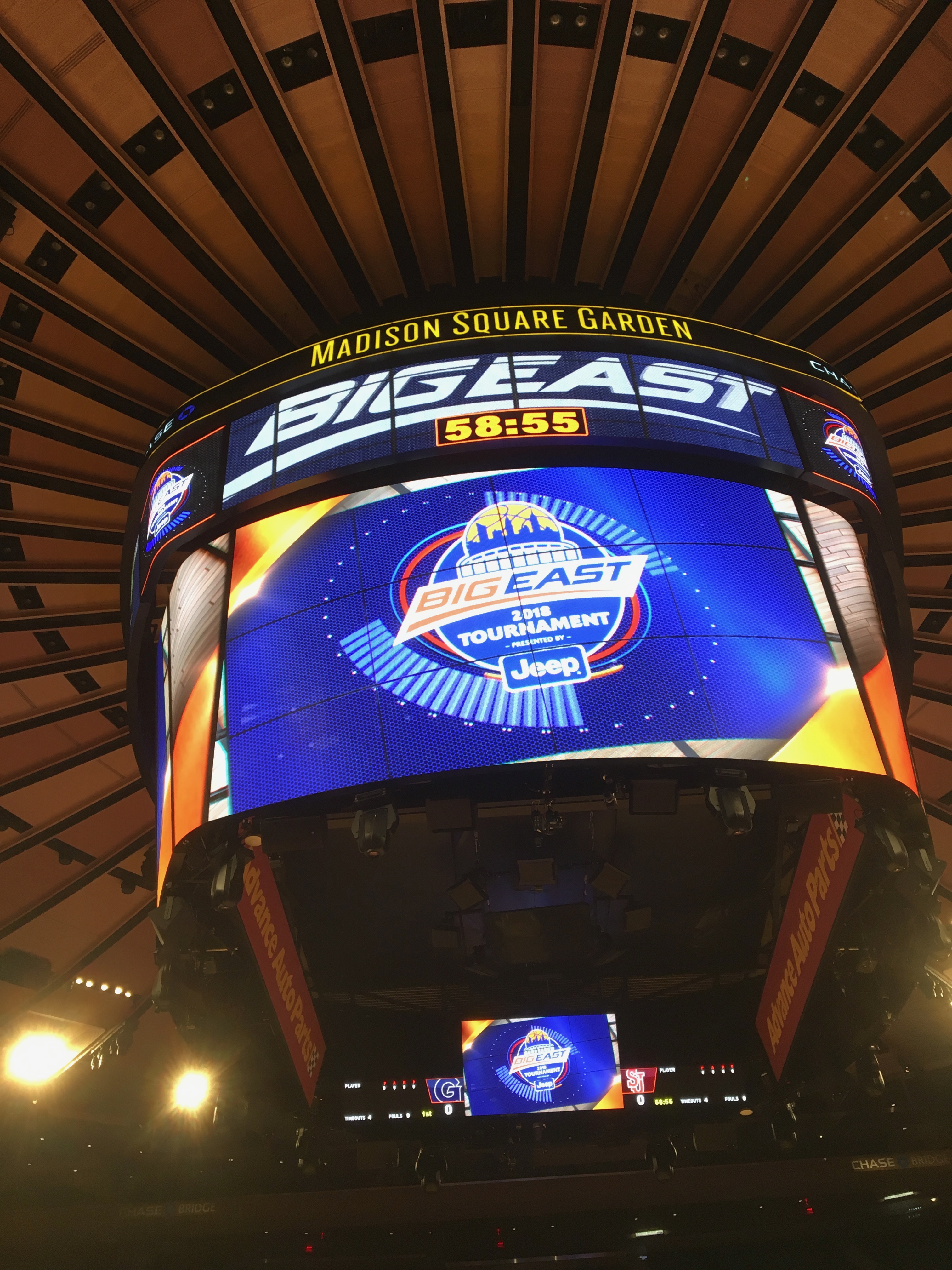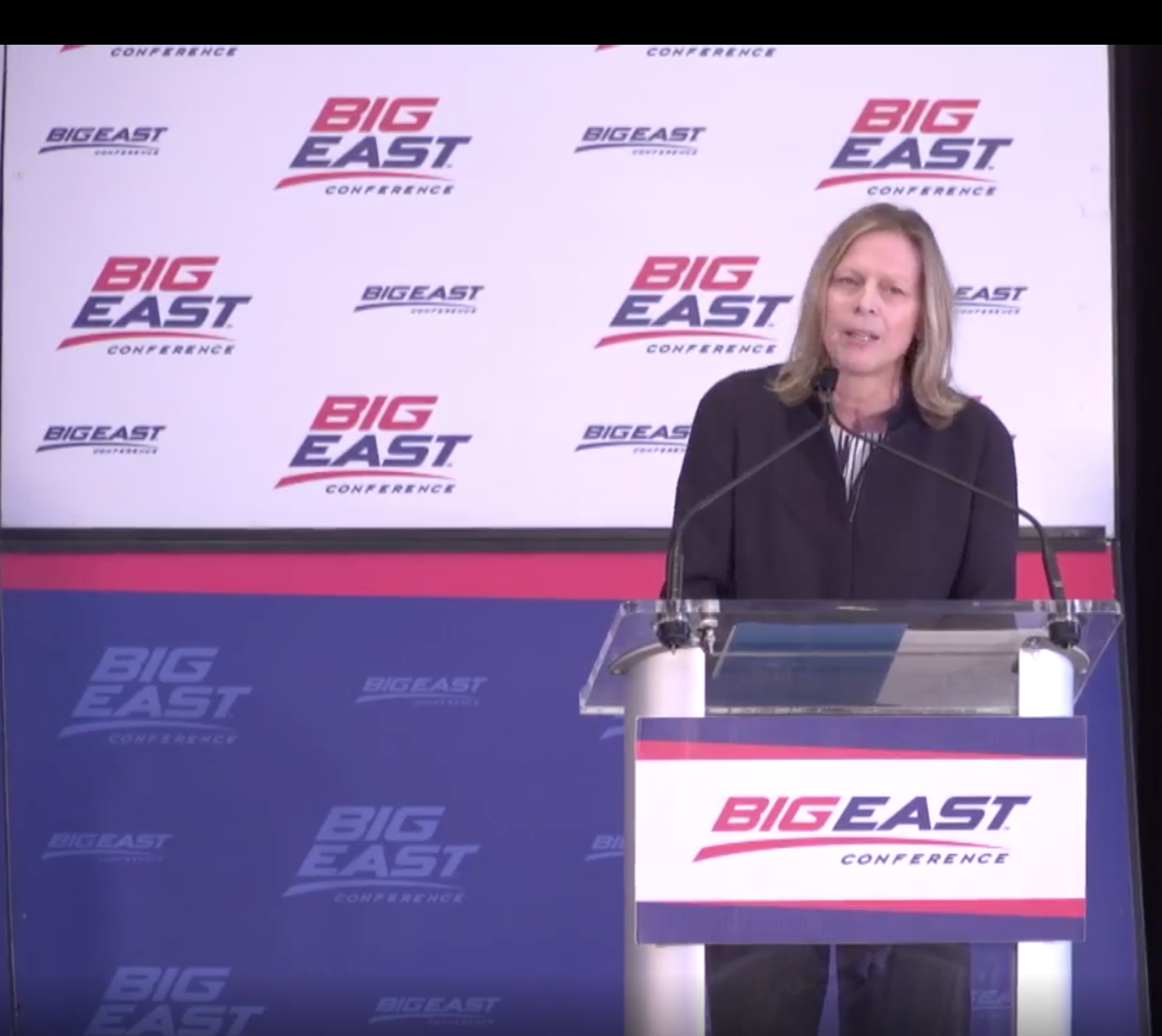BY KEN DAVIS
A week of rumors, speculation, breaking news, sourced confirmations, presidential votes, and trustee meetings ended with a press conference Thursday at New York’s Madison Square Garden.
University of Connecticut President Susan Herbst tied it all together with one brief and rather memorable statement.
“We feel like we’re home,” Herbst said.
Home meaning the Big East Conference, of course.
If you listened close enough you might have heard UConn basketball fans from Storrs, to Hartford, to New Haven, to every borough of New York and beyond, cheering that comment. That has been the predominant emotion in Husky Nation this week. The fan base is downright giddy over this reunion. The six-year divorce between UConn and the Big East Conference is over. They’ve patched up their differences and gone back to the wedding chapel.
It’s all about the basketball.
Smiles for everyone at UConn. Grins from everyone in the Big East office. Parties at the basketball schools that turn their noses in the air to football and the Football Bowl Subdivision.
UConn’s six-year relationship with the American Athletic Conference, which provided a step-family for the Huskies after the 2013 split of the Big East, likely will be permanently reduced to the chapters of a history book. That all depends on the future of the UConn football program, which will not be packed on the moving van leaving for the Big East.
Football is the story for down the road. Thursday was all about returning home – and the story of UConn clearly declaring itself a basketball school, a move that is rare in this football dominated era of college athletics.
But this is going to be messy. Realignment always is sloppy and painful. If anyone should know that it is UConn.
Big East Commissioner Val Ackerman put it this way, “The opportunity to add a member who is a national basketball brand, that’s in our geographic footprint, who has an outstanding fan base with proven support of our biggest annual event, and who brings the added bonus of having a deeply etched, shared history with us, intense rivalries with many of our schools. . . . All of that taken together represented an opportunity that we simply couldn’t pass up.”
But this is not your father’s Big East. Ackerman, with her NBA and WNBA background, is in charge now. The late Dave Gavitt, who pulled all this together and gave Eastern basketball a spot on the national scene in 1979, is gone. So is Mike Tranghese, who directed the Big East through the football age that spurred UConn to move to the I-A field and eventually gave the Huskies big-time aspirations.
Old rivals Syracuse, Boston College, Pittsburgh, Miami, West Virginia and Rutgers are gone. Familiar faces from Providence, Seton Hall, Georgetown, St. John’s, DePaul, Marquette and Villanova will greet the Huskies but there are new additions to the family from Butler, Creighton and Xavier.
The vote by the Big East presidents Tuesday was unanimous in approval of accepting the Huskies. The conference confirmed that in its press release Thursday.
Providence President Rev. Brian Shanley told the Providence Journal, “We believe that the return of UConn to the Big East will be a blessing to our student athletes, our fans, and all our supporters.”
A blessing. That’s good news for the Huskies, coming from the Head Friar.
Heck, even Syracuse coach Jim Boeheim, who helped construct the Big East along with Georgetown’s John Thompson, Villanova’s Rollie Massimino and Lou Carnesecca of St. John’s, seemed excited about the UConn news earlier this week. Boeheim is one of the Big East originals who skipped off to the Atlantic Coast Conference when Syracuse accepted an invitation in 2011.
“Well, it’s great for [UConn],” Boeheim said Saturday during a recruiting trip. “It’s a strong league and all their traditional rivals [are in the league]. It’s a great move, couldn’t be better.”
Another Big East coach, who was not named, was quoted saying that it restored “geographical balance back” to what the old Big East was and helps the conference recapture part of what made it great.
Men’s basketball coach Dan Hurley is the big winner in all of this. Hurley, who played for Seton Hall in the good old days against UConn and the rest, will be comfortable back in the Big East. He’s from New Jersey. And now his job is at a “Basketball School” with football taking a backseat in the tailgating section. Hurley battled through a tough first season, put together a decent recruiting class and now has the spark he needs to bring in even better prospects.
Advantage Hurley. It’s also more pressure. But Hurley has never been known to run away from pressure.
Even though UConn wasn’t ready for big-time college athletics in 1979, Gavitt extended an invitation to become an original member of the Big East to then-athletic director John Toner. UConn experienced every high and low that went along with membership from then until 2013 when the so-called Catholic schools declared they had absorbed enough and broke apart from the football schools. Along the way there was a painful and unprecedented lawsuit in 2003, started by UConn, with the support of four other Big East schools, that attempted to block Miami and Boston College from leaving for the Atlantic Coast Conference.
Philip E. Austin, then president at UConn, called that a painful, last resort. “People can come and go,” said Lew Perkins, UConn athletic director at that time. “It’s how you come and go that we are dealing with.”
The bad feelings with the Big East have melted away but the concern remains the same. UConn is both coming and going. And the football program is in total limbo.
Despite the glowing press conference at Madison Square Garden and all the “Welcome Back UConn” signs supplied by the Big East, the process of dealing with another shift – especially the fate of the football program – is something UConn, the Big East, and the AAC will have to deal with in the coming weeks. It won’t be smooth.
The only comment from football coach Randy Edsall came in a statement released to the media Wednesday. Football just got a new locker room and new uniforms. The team is preparing for next season. It seems Edsall was blindsided by this decision and now says his program is in a state of transition. The Huskies will play in the AAC again in 2019 but after that it is anybody’s guess. An independent schedule might be the only alternative and that isn’t a great option for any program with the exception of Notre Dame.
“Myself, my staff and my players will not address this situation in the future as our focus is all on the 2019 season which is right around the corner,” Edsall said in his statement. “So with that being said, we’ve moved on to [opening opponent] Wagner College.”
UConn athletic director David Benedict told reporters Thursday that he is committed to the FBS. He has no intention of downgrading the program.
“The plan is that we have to have a discussion with Commissioner [Mike] Aresco and the American, which I look forward to doing as soon as possible,” Benedict said. “That’s where it’s got to start.”
Scrap that plan. According to Aresco, that isn’t going to happen. He told Pat Eaton-Robb of The Associated Press that there is no chance of UConn staying as a member of the AAC. Aresco was asked if the league would be interested in retaining UConn’s football program.
“The short answer is no, not a chance,” he said.
UConn is required to stay in the AAC for 27 months. If UConn wants out sooner, Aresco says the school must take the initiative to talk to the AAC.
The national perception, reflected in columns from around the country, is that UConn is sacrificing football. The Huskies are 41 games under .500 since losing to Oklahoma in the 2011 Fiesta Bowl. There is little respect for the Huskies from the ACC to the WAC.
UConn has made it clear since the 2013 separation of the Big East that the AAC was not the desired destination for the Huskies. The Huskies have been searching for alternatives all along. It may not be a surprise that they are leaving, but they won’t get any sympathy from anyone in the AAC.
“It’s a national brand,” Houston coach Kelvin Sampson told Houston reporter Joseph Duarte. “But the bell cow of our conference has been Cincinnati.”
UConn’s athletic department, which reported itself for spending $40 million more than it earned in 2018, will face exit fees and entrance fees on top of all the other coaching contract issues the school has inherited recently. But Herbst and Benedict clearly were not pleased by the new television deal reached between the AAC and ESPN in the spring. They weren’t happy that UConn’s deal for women’s basketball with SNY was threatened. That drove the to move toward the Big East. Ackerman confirmed that discussions started after the last basketball season and increased in intensity the past few weeks.
“Initially we have more costs because we have to pay our entrance fee and have some work to do with the American,” Herbst said. “This is about the long-term, our long-term future. Over the long-term, because of the travel changes, we’re going to save a couple million dollars a year because the schools are easier to get to than they are in the American.”
That seems to satisfy Herbst and the others. UConn officials say that ticket sales and renewals have already been positively influenced this week. They know the fan base will be happy about the Big East move. But the fan base should understand this hasn’t been done for their pleasure.
As always, this is about TV deals. It’s about money. And we now know that UConn really doesn’t care about the football fans – if there are any remaining. This is proactive measure built on basketball – something UConn has never done.
And don’t think for one moment that the Big East felt any sympathy for those old friends in Storrs. The motivation is much the same on the other side.
Villanova, with its two national championships in men’s basketball this decade, has been carrying the league. Providence has been better off and so has St. John’s, Seton Hall and Marquette, but they haven’t made a huge national impact. Creighton, Butler and Xavier will never carry the Big East banner.
The league needed another Top 25 team to consistently enhance the Big East reputation – along with Villanova. That’s behind the unanimous vote by the presidents. That’s what UConn has been hired to provide.
These days, it’s called a better brand.
“We thought we were sitting pretty for a while,” Ackerman said. “We were settling into the 10-team new Big East. But as I said, when this opportunity presented itself to readmit a charter member, who has as blue blood a basketball pedigree as anybody, who is down the road with a great fan base, . . . with this shared history with this league that has survived everything in the last 41 years, it’s just something we felt we had to capitalize on.”
Even if the process does get a little messy at times, UConn and the Big East seem meant for one another.
Welcome home.




Speak Your Mind